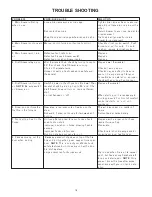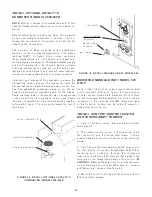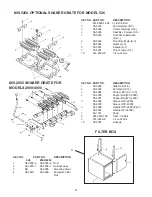
18
Your unit should be place on a non-combustible floor or
3/8" thick fireproof millboard or equivalent which ex-
tends at least 8" from the sides and rear and extends
24" from the front. Leave a minimum clearance of 36" in
front of your unit. This is for safe, easy loading and
cleaning of your unit.
Also be sure to allow enough room at the rear of the
Woodchuck for installation of the circulating blower and
filter box.
If using your unit as an add-on, 6" minimum clearance
is required from your present furnace.
One very important step in locating your wood/coal fur-
nace is how much distance you will be from your new or
existing chimney. The unit should be installed as close
to the chimney as possible with a minimum of elbows
(no more than 2) and no more than 6 feet horizontally
with ½" rise per foot.
CHIMNEY INSTALLATION
It is extremely important that your Woodchuck furnace
be installed into a CLASS A CHIMNEY ONLY. These
chimneys consist of a flue-lined masonry chimney or
an approved Class A All Fuel factory built metal type.
Any other installation constitutes a fire hazard, as wood
and coal burning units have stack temperatures as
much as 300° to 1000° and may also deposit creosote
which can ignite and cause severe damage to any
chimney. MAKE SURE YOUR WOODCHUCK IS IN-
STALLED INTO A PROPER CHIMNEY.
For maximum safety and efficiency never install the
Woodchuck furnace into the same chimney serving an-
other appliance.
A typical chimney checklist of requirements is depicted
on figure 8.
The Model 526 furnace is equipped with a 6" flue collar
having 28 sq. in. of exhaust area. Models 2900 and 4000
have an 8" flue collar having 50 sq. in. of exhaust area.
When connecting the furnace to the chimney maintain a
chimney flue section giving these minimum areas or
larger but not exceeding twice this area. Some common
sizes that are acceptable are 8" round, 10" round, or
8"x12" rectangular. All Woodchuck furnaces must be in-
stalled into a chimney developing a minimum of .04 W.C.
to a maximum of .06 W.C. inches of draft. To maintain
this range of draft, a barometric damper should be in-
stalled (see pgs. 18-20) on each unit when the draft from
the chimney is capable of exceeding .06 W.C. inches of
draft.
Insufficient draft can contribute to smoke spillage when
the loading door is opened and to rapid creosote accu-
mulation. Excessive draft can cause high flue gas tem-
perature, loss of overall efficiency and effect the degree
of control the operator can exert on the unit.
FIGURE 9 CHIMNEY/ROOF CLEARANCE
TYPICAL STOVE PIPE INSTALLATION
10 MIN.
2 MIN.
APPROVED CHIMNEY
6" OR 7" PIPE FOR
MODEL 526
8" PIPE FOR
MODELS
2900/4000
DAMPER
3 MIN.
SIDE VIEW
FRONT VIEW
DAMPER
STOVE PIPE
APPROVED
CHIMNEY
2 MIN.












































